Kansas State Fair provides inspiration for unique, hands-on learning experience
A chainsaw-wielding man carefully carves intricate designs into large logs. Sows give birth to squealing piglets. Children scream with delight while spinning around on a carousel or flying down the giant yellow slide towering three stories above onlookers. A hypnotist enthralls audiences, and a cow sculpted from butter stands among sunflowers in a glass cage. All the while smells of fried foods and grilled meats float on the incessant breeze.
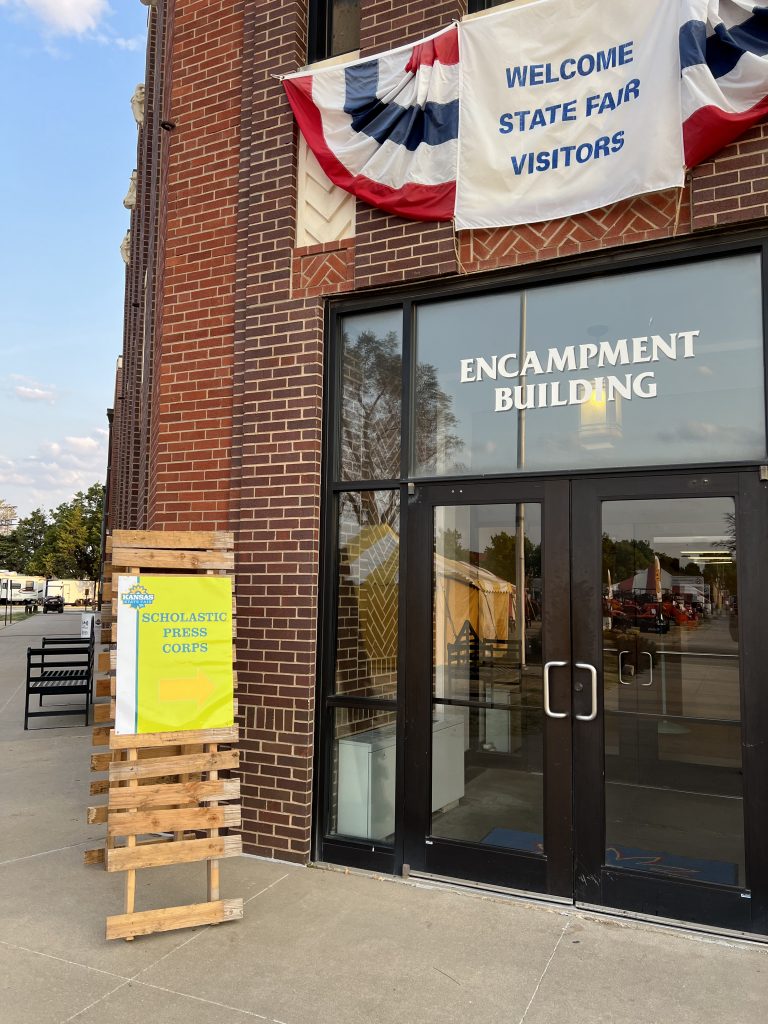
This type of sensory overload isn’t normal for the typical classroom, but when the Kansas State Fair is the classroom for the day, such experiences are common.
Each year the fair gives high school journalism students from across the state the opportunity to do journalism in an immersive and real-world environment as part of a specialized education program called the Scholastic Press Corps.
During the five weekdays of the fair, teams of five journalists show up to produce content about their assigned day. Some teams create a four-page newsletter, and other teams produce a four-minute broadcast or promotional video. Either way, they are assigned one agriculture-focused story, and they must draw a second story from a hat . . . or plastic coffee container as the case might be.
These two required stories have time or word-count requirements, but the rest of the overall product’s content is up to the teams as long as it is about that day at the fair. They just have to turn it in before 6 p.m. or they are disqualified, and they can’t do any work prior to arriving at the fair around 9 a.m., except for maybe setting up a design template.
Linda Drake — the journalism adviser at Chase County High School in Cottonwood Falls, Kansas — participates each year.
“SPC offers students that opportunity to put the skills we work on in class to use in a real-world atmosphere. They have to apply those skills in a situation that requires them to research topics that they don’t always know all the details about, to interview people they don’t know, to work under pressure, and to work as a team under these conditions,” she said. “I think it’s a great learning experience for all of my students, those who are more advanced as well as the beginners. Time management also plays a key role in this competition as well, which is a great skill to learn early in the school year before so many publication deadlines start.”
Presenting authentic journalistic experiences
In this way, the SPC competition provides remarkable exposure to project-based learning (PBL), which serves as a wonderful motivational tool because it creates a way for students to go out into the world instead of remaining confined to the classroom or school campus.
And what a busy, chaotic world the fair is. Just like a school or community, there are tons of things going on that they could report on. Choosing the right piece and the right angle to cover it from provides an extra challenge.
As educational philosopher John Dewey advocated for, this program provides experiential learning. As scholar Yonty Friesem pointed out, this necessitates creating work for “an authentic audience.”
That’s what high school media programs do anyway, and a hands-on experience like the SPC allows students to target a brand-new audience to serve via their journalism. Also, it allows students to practice their professional skills, such as determining newsworthiness, and other transferable skills such as information gathering and general communication.
“The state fair competition gives my students a great opportunity to have hands-on experience in a unique environment,” Drake said.
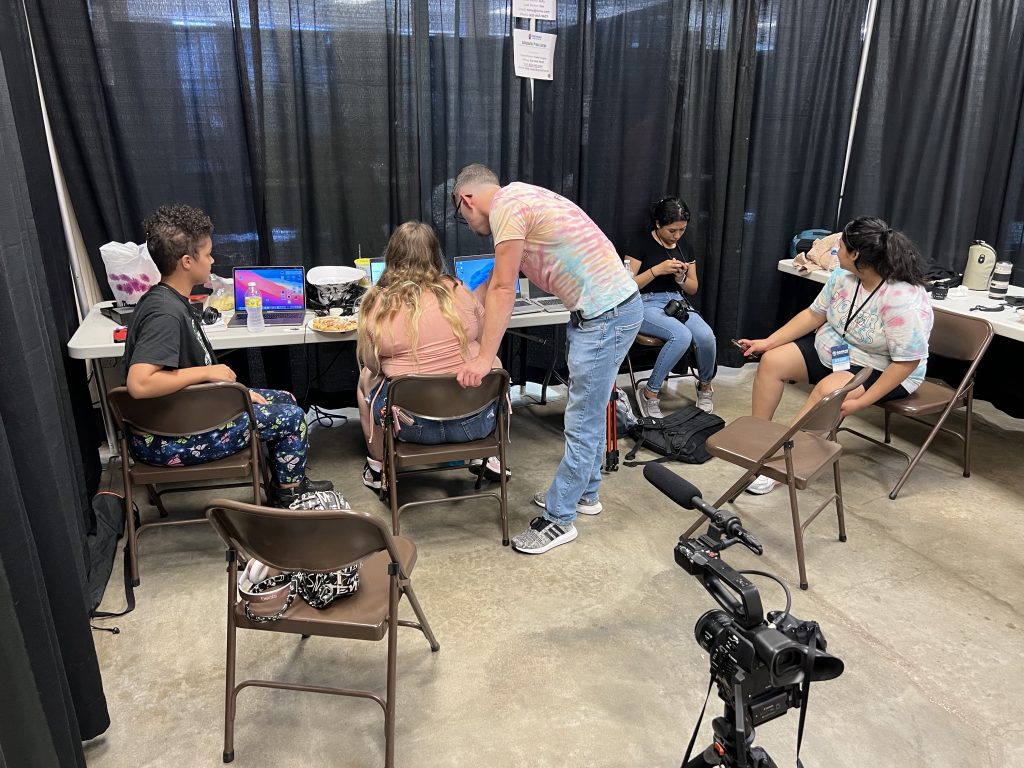
Furthermore, incorporating such activity into a journalism program checks off numerous educational objectives. It inherently requires and involves technology use in order to create the newsletter or video project, and the students have to use that technology in the field. Also, assessment is built in through the judging process of the learning artifacts that are created, and it provides rigor by requiring all the work to be done onsite and independently by the deadline, among other objectives.
“They utilize the classroom skills they have acquired in a real-life environment. They interview, they write, they take photos and shoot video all based on topics either assigned or chosen, and they must learn how to deal with time management and stress all while organizing and creating real projects,” Drake said. “These are all skills we use on a daily basis both in our journalism classrooms, and that they will use in their life after high school. This is a win-win opportunity for both students and advisers.”
For the 2022 edition of the SPC, which took place Sept. 12-16, 38 teams from 28 schools traveled to Hutchinson, Kansas, to trek back and forth across the 280 acres of the fairgrounds, experiencing what it is like to do daily journalism, including dealing with the public as part of the 315,273 total 2022 fair attendees.
Derby (Kansas) High School journalism adviser Joanna Chadwick said she took 21,000 steps during the day her students participated, and she was just observing her team in action as they raced around to gather interviews and photos for their newsletter entry.
SPC evolves, grows over years of operation
For Kansas advisers like Drake and Chadwick, the opportunity to take students to the fair to do more than ride rides and spend money on ridiculous tchotchkes is thanks to Janet Hallford.
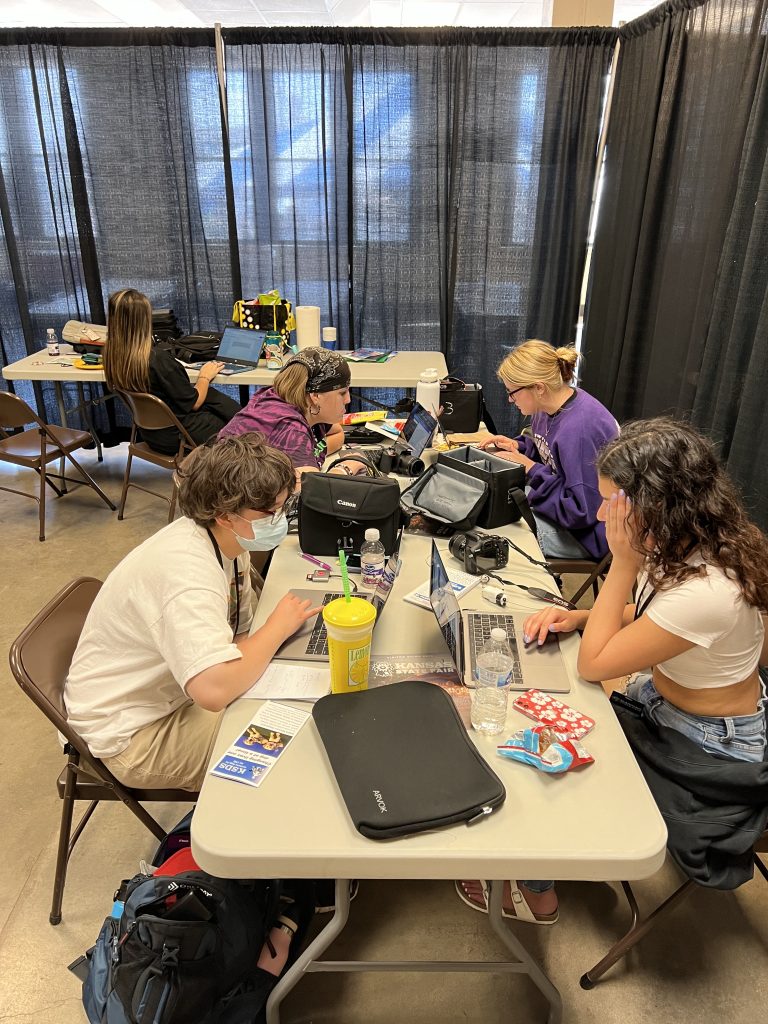
Hallford, a retired journalism instructor from Hutchinson Community College, started the SPC in 2007.
“I had a KSF administrator in some of my evening Photoshop and InDesign classes,” she said. “When she found out I was retiring in May 2007, she contacted me about possibly starting a program for media students at the KSF.”
Then Hallford was off to the races, working with fair officials to launch the program.
She had to do some marketing to get journalism teachers interested, and she contacted the state-wide high school journalism organization — the Kansas Scholastic Press Association — for membership lists so flyers could be sent to advisers.
To pilot the idea, five newsletter and five video teams were invited to participate, meaning one newsletter and one video team was able to compete each day, but it continued to grow and evolve as it gained momentum thanks to word spreading about the unique experience.
By the second year, Hallford expanded the program to allow for two newsletter and two video teams each day.
“By the third year, we were having to put schools on a waiting list,” she said. “Each year we had more and more schools apply. The KSF administration started renting portable classrooms to accommodate everyone.”
This year, the SPC had space for 10 teams each day, the largest number of slots in the program’s history.
When I was a high school journalism adviser, I always tried to take my students to the SPC competition. The experience is simply unmatched when compared to what can be accomplished in the daily classroom.
My students always enjoyed it, and so did Alexis DeLong, the co-editor of Chase County’s yearbook.
“I think this was a very beneficial experience. I really liked how hands-on it was. This was a good real-life experience where we had to actually go out and get information from people we didn’t know,” she said. “Going into it I was a little nervous, but at the end of the day, I felt very accomplished. Back at school, this is going to motivate me to continue to push forward and never give up. This showed me what my classmates and I are capable of doing. I’m so glad I had the opportunity to be a part of this.”
To Hallford, that’s the best part of the program and why advisers and their students should participate in this type of event.
“It puts what they teach in the classroom into a very real experience for their students,” she said. “So many things can’t be controlled when producing at a remote site as it can be in a classroom, thus students had to think on their feet. I had many teachers tell me that it was the best experience they could provide for their students.”
This is why I took the reins of the program in 2020 and became the SPC coordinator. I jumped on the chance when KSF Education Manager Jacki Eckert contacted me to gauge my interest.
It was a no-brainer. Besides my love for the fair and all things fried, I wanted to do anything I could to serve the SPC and continue to provide Kansas journalism students the opportunity to participate in the program.
It’s that impactful.
SPC can be inspiration, template for others
Kansas is lucky to have such an event for high school students, and other states or regions should replicate the SPC program as a way to increase engagement and student learning within the journalism curriculum.
According to Hallford, doing so just makes sense.
“As a teacher, I have always believed that students learn best by doing. Yes, they need to be taught fundamentals, but then give them experiences as close to real life as possible,” she said. “Nothing can better prepare them for an actual print or video career than requiring them to interview strangers instead of schoolmates, to have to work independently of your teacher, and to make them face the reality of a tight deadline.”
The model could be replicated at any state fair. Such a setting is nice because of the diversity of events and coverage options present. However, the concept could be adapted as well.
For example, a similar program could be set up at a music festival, flea market, craft show, or even the zoo. That’s the beauty of this model. It can work on a large or small scale.
A state-wide organization, such as a fair or a scholastic press association, could organize a program, or a single journalism program could develop its own experiential, hands-on learning. All that’s needed is a little creativity.
“Anytime an organization can offer students an opportunity to get real-world experiences is wonderful. Students love the idea of competition, and it is very rewarding for them to know that they can take skills they have learned and apply them to completing a real project. It helps validate the learning process,” Drake said. “An added bonus is for the advisers who have the opportunity to see their students work together planning the project and actually executing it without constant guidance from them, the advisers. It also helps us evaluate what skills we might need to work on more in the classroom environment.”
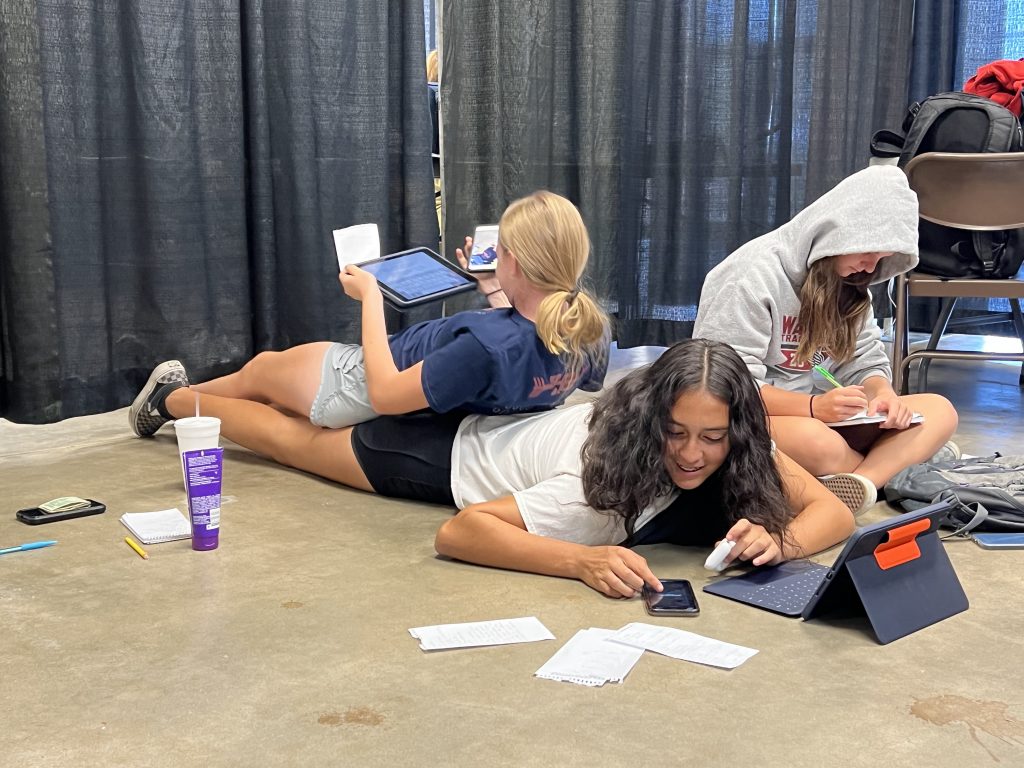
The SPC doesn’t provide equipment, templates, or anything else of that nature. What it provides is space and Internet connections to work, access to the fair and its amenities, support and guidance, judging based upon predefined parameters and rubrics, and, in true state fair fashion, ribbons for the winners.
It’s set up in a way that allows schools to participate with whatever equipment, knowledge, and skills they have. This lowers the barrier to entry and creates a welcoming and inclusive environment for student learning.
“Working with teammates was definitely a bonding experience and taught me the importance of teamwork and working efficiently together. These skills will be useful back at school when working on our own yearbook,” Chase County senior copy editor Avia Banks said. “I also feel like it’s beneficial to all people involved when you have to search for your resources. It brings critical thinking into the process, and you have to be creative when trying to write a story. I definitely feel like this experience is great for all writing teams, video teams and photographers because it teaches them the very important information they need to collect to create a newspaper, or video, with limited time.”
That is the point of the SPC. It is a learning experience that has a contest component associated with it.
Some schools may not complete their newsletters or videos in time to be judged, but they leave having learned more about doing journalism, which increases their knowledge and skills.
Also, technology isn’t a barrier.
For example, some schools might use Adobe InDesign to design their newsletters, but others may not. In fact, the number of teams using Canva for design purposes has been steadily increasing because of its affordability, ease of use, and availability on any operating system, such as Google Chromebooks that many schools use as student computers.
Likewise, video production doesn’t require the most expensive cameras and microphones. Though some schools bring this type of equipment with them, others use their cellphones and produce incredible content.
No matter what is used, though, working under the real-life deadline pressure of the SPC teaches students they can produce high-quality journalism quickly and efficiently. One adviser told me he makes this exact point with his students when they express concern about completing reporting assignments throughout the year.
Also, the SPC can reveal determination within students. For example, Pittsburg High School’s video team consisted of one person, and that student shot and edited the entire video before the deadline, successfully entering the contest as a solo contender.
By participating in the SPC or any similar experience, students are exposed to journalism in a way that is truly unique. Some college programs might offer options analogous to the SPC, but such opportunities are lacking for high school journalists.
That needs to change.
So, if you aren’t already, I encourage you to find a way to augment your student journalism program by incorporating an additional intensive and experiential, hands-on learning endeavor into your curriculum.
I’d be happy to share my ideas and insights with you in more detail if you so desire because the students and your journalism program will reap the benefits of this type of learning.
“I believe this is a great opportunity for all educators to participate in at least once. I think they will be hooked after that. This project just reinforces what we do in our classrooms on a daily basis, but in a real-world situation. It helps us as educators figure out where we need to add more classroom instruction, or what soft skills we still need to work on,” Drake said. “But there is nothing better than watching our students meet new people, work with classmates in a real-world atmosphere, apply their journalistic skills and then create a project of their own without guidance from their teacher. That look of accomplishment, and relief, when it is finished is priceless.”
And, if you partner with a county or state fair, your students might gain the added benefit of learning where milk comes from by milking a cow or bonding with their fellow team members while de-stressing by getting scared on a ride such as the Kansas State Fair’s historic Ye Old Mill.
No matter what, though, the effort of being involved with a real-world program like the SPC will be well worth it.

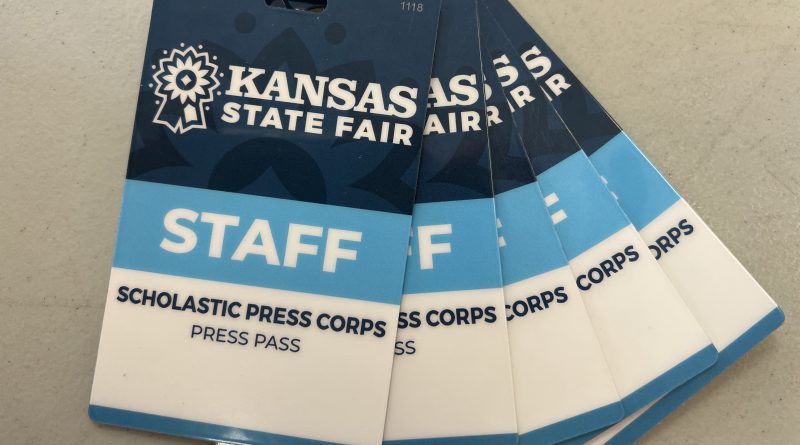

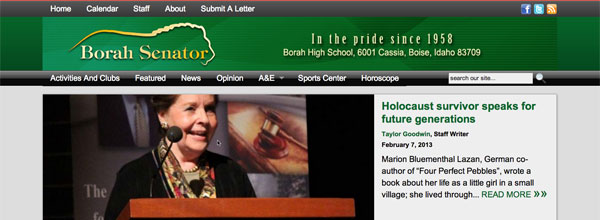
A butter-sculpted cow stands among sunflowers in a glass cage, as a hypnotist captivates crowds. Regards from roof restoration auckland team!